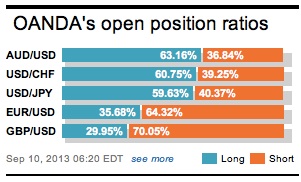Plenty of constructive headlines on Syria combined with lower oil prices to a certain extent are helping improve risk appetite as investor’s head to the North American market open. The latest data from China continues to point towards a recovery in the world’s second largest economy, appropriately in time for their Communist’s party key meeting in November.
Some consistent signs of a stabilizing economy in China have supported sentiment in Asia in recent weeks and it seems that investors want to spread more of that ‘love.’ Chinese month-end data for August shows the first double-digit industrial output growth rate (+10.4%) in nearly a year, accelerating from a +9.7% on-year increase in July. In addition, the country’s retail sales accelerated +13.4% last month year-on-year from +13.2% the previous month. Mind you, its comrade Mother Russia’s proposal on Syria to put its chemical weapons under international control (no official response yet) has also being helping investor risk appetite. President Obama said that he would put planned air strikes on hold if the regime of Bashar al-Assad followed the proposal to hand over control of the country’s chemical weapons stocks.

Together with the hope that Fed tapering will be “prudent” is certainly reassuring the various asset classes. Recovery and relief trades have been dominating “play,” although doubts about how long the current market optimism will last are preventing an “outright” embracing of risk by investors. Currently, it seems that the various resistance levels are keenly watched, especially in the emerging markets where the market sell off has been more severe in the past couple of weeks. For instance, the Indian Rupee’s move has been the market-leading contender for a perfect example of volatility.
There are some market fears that the EM recovery could be as sharp as the recent sell off. For almost anyone, the return of real money willing to put balance sheets to work is a very positive sign for all markets. Already this week there has been two EM bond deals from Russia and South Africa. If nothing else, investors should take it as a sign that the recent EM sell off has created some ‘value.’

The IMF’s Lagarde is getting her allotted airtime so far this week. Yesterday, her concerns were mostly about the Fed and their potential tapering timetable and speed. Indicating that the US must be well aware of her “global responsibilities” before embarking along the path of liquidity reduction – the knock on negative global affect could aggressively negatively compound when the process is incorrectly handled.

Today, her focus is on the euro-zone, admitting that it still has a ways to go in building a fiscal union to deal with future crises. Lagarde said that “greater fiscal integration would help the euro-zone absorb shocks for individual countries, it would help with governance and would limit contagion.” She did admit that Europe had made some significant progress on increasing oversight of national budgets, but “the rules will only be good if properly enforced.” The IMF envisions a stronger risk sharing mechanism, a “rainy day fund,” with a credible “pan-European backstop for the resolution of banks.” Currently the ESM is in place, but more clarity is required.
Little has been said on Swiss rates of late, aside from the SNB having no immediate intention to shift the “floor.” The fixed income market has been pricing in the SNB to keep their interest rates near “zero” and to defend it’s floor of CHF1.20 throughout all of next-year, as the global climate will continue to restrict its room for maneuver. The revival in the industrial economies is not expected to be enough to offset the ongoing “weak labor markets, or allow the ECB to exit their key low interest rate policies.” Analysts believe that with the absence of an overheated Swiss labor market, coupled with a stronger franc should keep Swiss price pressures lower until 2015 at least. Under this scenario, this will allow the SNB to continue to pursue an ‘expansive monetary policy.’
For the current Italian crisis “the Berlusconi hearing” the markets are looking at the Italian/Spanish 10-year spreads for guidance. Instead of the 10-spread of BTP’s to bunds the movement on the 10-year Italy/Spain spread is providing a more accurate read on market concerns over Italian politics. Since August, BTP’s/Bunds have moved sideways while Italy/Spain have gone from +30bps to zero.

The EUR’s rally since the NFP print has squeezed the life out of many shorts held after the print. Will the safety of the dollar still be needed? Syria remains unresolved, however, the real reason why investors may look to be long USD’s will be next weeks FOMC meet. Will traders want to be long EUR’s heading into an event that may actually be “The Game Changer” and a reason for a higher dollar?

Other Links:
Lame Trading
Dean Popplewell, Director of Currency Analysis and Research @ OANDA MarketPulseFX
This article is for general information purposes only. It is not investment advice or a solution to buy or sell securities. Opinions are the authors; not necessarily that of OANDA Corporation or any of its affiliates, subsidiaries, officers or directors. Leveraged trading is high risk and not suitable for all. You could lose all of your deposited funds.


